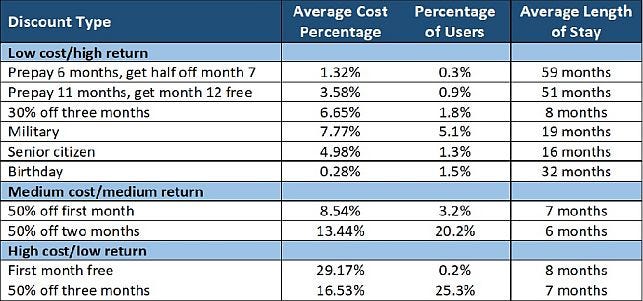Self-Storage Discounts and Specials: Which Ones Really Work and When to Use Them
Though many self-storage facilities are enjoying high occupancy these days, rental discounts and specials can still play a vital role in your revenue-management plan. But they must be executed carefully and tracked to assess their effectiveness. Read guidance on which programs fare better than others and when you should use them.
September 3, 2022

In the history of self-storage, there have been times when it seemed like everyone was giving away the farm to fill units. Though discounts and promotional specials have dropped drastically in recent months due to high occupancies, many operators are still using them online to entice customers to choose them over competitors. This is fine, as our online shoppers are the one most price-sensitive, unlike our walk-ins or repeat tenants.
The important thing is that we’re only using discounts in certain circumstances. Knowing when, where and how to employ them is key. I’ll address these points below and also share the specials that work best.
Looking at the Numbers
What is your self-storage company willing to pay to compete and win new business, and what is each customer worth? To answer this, you need to know the lifetime value of each tenant. At my company, our average customer value is more than $3,500. We compute this by multiplying the average length of stay in days by the average price per square foot by the average unit size. To determine our cost per lease, we divide the total cost of all marketing and advertising by the total number of signed leases for the same period. (Currently, we’re at $52.) Once you know this number, you can determine what, if any, discounts you should offer to entice renters.
There are many ways to weigh the value of promotional specials. The most important question to answer is what customer length of stay and return you get from using discounts and which ones bring you the best return. In reviewing our data from past programs, my company has determined that a special generally falls into one of three categories:
Low cost/high return
Medium cost/medium return
High cost/low return
For each group, there’s a percentage of rent cost, a percentage of users who received the discount, and an average length of stay. The following table includes specials we offered in 2020 and 2021, both in store and online. The average cost is the percentage of all rent charged over the life of the customer, and the average length of stay is through February 2022.

Based on this analysis, we decided to continue using the following promotions:
Military, senior citizen and birthday at 10%
Prepay six months and get the seventh month at 50% off
Prepay 11 months and get the twelfth month free
30% off of three months
50% off the first month
50% off two months.
Notice that the first-month free special is the most expensive of all the discount programs. This is why we don’t offer that one very often. We also find it’s the most common among our competitors. We want to have a longer discount period than other facilities when lots of units are available so our business looks more attractive and our net rental price is lower than theirs—especially online. For instance, our 50% off price equates to more savings than their special and for a longer period.
We stay away from first-month free because want to see income from new rentals, ensure quality tenants and spread the discount over time. Plus, we know that great customer service, a well-managed property and competitive pricing will always outperform cheap prices and poor service.
Careful Pricing
When used in self-storage, specials must be meaningful. For example, if you have very few of a particular unit size and type available, no discount should be given. This is especially true now for most stabilized stores as occupancies are the highest the industry has ever seen. However, if you just opened a new site and have lots of vacancy, promos are more appropriate.
Be careful, though, about how long you leave these discounts in place, as certain unit types are full around the country. These include drive-up, climate-controlled units; contractor-sized units; and enclosed or covered boat/RV-storage units. When these units become full—85% or higher occupancy—raise the rates before you run out of them.
Never use an open-ended discount period for move-ins or on all unit sizes. Specials should be based on availability within specific types. Group units together to better manage pricing, for example:
Traditional drive-up units
Drive-up, climate-controlled units
Interior, ground-floor, climate-controlled units
Interior, upper-level units
By segregating your unit types, you’ll have a much easier job of managing rental rates, including which discounts you use and promotion length.
You must also look to see what your competitors are charging for a like-kind space and their availability. Knowing them personally is best. Find out what they offer and what makes you and your property unique compared to them. There’s no reason for a class-A site to have the same price on a 10-by-10 as an older, obsolete facility with no technology. Many of my company’s properties are the highest priced in their markets, yet they’re full. Remember, the market price leader always has the highest occupancy!
One key point to remember is you don’t want to be the lowest price in town unless what you’re offering is the least desirable. Customers primarily choose us because of convenience and location, as shown in the following chart, with only 15% basing their choice on price alone.
Tracking Results
Discounting still has a place in self-storage and can be beneficial. It can stimulate leasing momentum and prevent you from taking a vacancy loss, which can never be recovered. However, it does have one significant drawback: lower net rental income. You must be cognizant of what the special is costing you and the specific results each.
Tracking each program and source of business is part of the analysis that must be done when offering discounts. Knowing how each customer found you along with other pertinent marketing and demographic data leads to better decision-making and higher profit. It’s best to stay away from long-term reductions and widely applied discounts. Rather, customize your offering based on what’s happening in the marketplace. If competitors offer a low price on a unit but have none to sell, their price is irrelevant. Why discount your product when you have the only availability in town?
When you use self-storage discounts and promotions wisely, they aren’t only affordable but work well and help fill units. Then it’s up to you and your great facility managers to keep those customers happy and paying an ever-increasing amount of rent.
M. Anne Ballard is president of training, marketing and developmental services for Universal Storage Group and the founder of Universal Management Co. She’s past president of the Georgia Self Storage Association and has served on the national Self Storage Association board of directors. She’s also participated in the planning, design and operation of numerous self-storage facilities. For more information, call 770.801.1888.
About the Author(s)
You May Also Like





